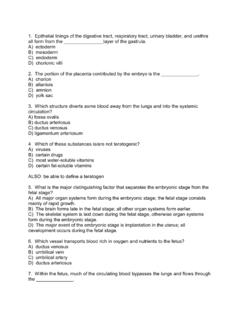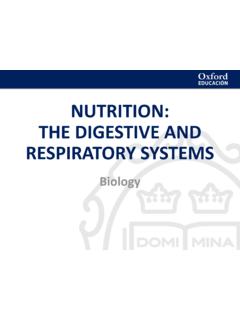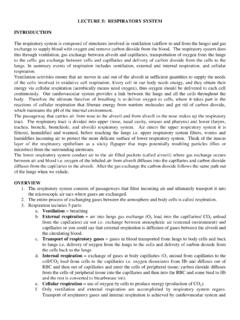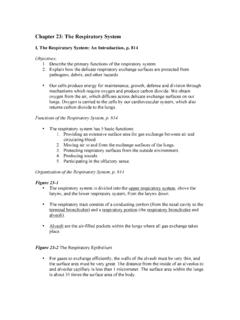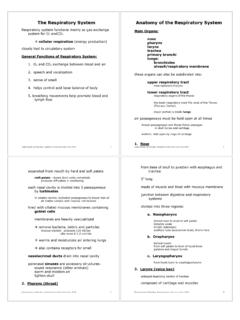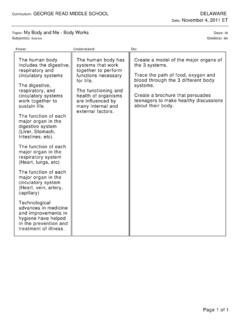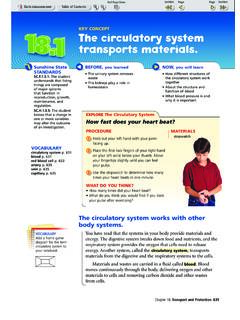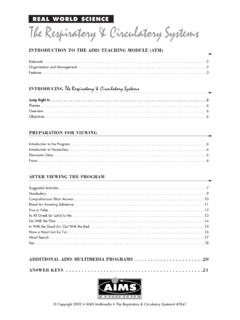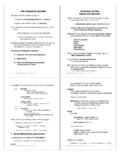Transcription of Digestive & Respiratory System Anterior Respiratory …
1 Digestive & Respiratory System Anterior Respiratory dissection We will be looking at both systems during this dissection . The cat Respiratory dissection WILL BE ON THE NEXT LAB PRACTICAL!! We will do 2 different Cat Respiratory dissection . Some groups should do an Anterior dissection , while other will do a Sagittal dissection . This guide is for the frontal section. Make sure to look at both dissections, as they will both be on the practical. THE TERMS YOU NEED FOR THE PRACTICAL ARE IN THIS dissection GUIDE. Instructions: Do one of the 2 Respiratory dissections, and then the Digestive dissection . Wordlist for cat Respiratory dissection ( Anterior section) Cartilaginous rings of the trachea Cricoid cartilage Diaphragm Esophagus Epiglottis Frenulum (lingual only) Glottis Hard palate Larynx Lingual tonsil Nasopharynx (opening into) Palatine tonsils Parotid gland Pleura - parietal and visceral Pharyngeal tonsils (maybe) Primary bronchi Secondary bronchi Soft palate Teeth incisors & canines Thyroid cartilage Thyroid gland (if present) Trachea Lungs (know the lobes) Vocal folds/cords A) Anterior Respiratory TRACT dissection ( of class) 1.
2 Prepare the cat! we do anything! Is there fur on the cat s neck? We must remove it to expose the neck muscles. And, you need to be able to see the mandible! See figure 1. On at least one side, you should remove the skin up to the base of the ear so you can see the parotid gland. NOW WE PRY OPEN THE JAW! Palpate where the mandible articulates with the Temporal bone (remember the TMJ from A&P1?). Feel towards the back of the zygomatic arch, by the ear. Move the lower jaw up and down a little if you are having trouble finding it. See the dashed line in figure 2. Take a scalpel and cut through the corners of the mouth, towards the spot you just palpated. We are going to CAREFULLY cut through the TMJ, but be very careful because you do not want to break the scalpel blade! Just get the mouth as opened as you can. Watch cats can still bite, and those teeth are sharp!
3 2. Now, examine the mouth. See everything labeled in figure 2. NOT PICTURED: Locate the oropharynx, with the uvula hanging down, and the pharynx. Can you see the junction between the soft and hard palates? You will also notice the frenulum which is made of connective tissue and skin and is responsible for holding the tongue to the floor of the mouth. Neck area cleaned of fur Mandible Parotid gland 1 2 3. Go deeper. Pull the tongue out as far as you can and find everything you can in figure 3. If you can t see the epiglottis yet, don t worry. You will in a bit. Notice the cat's tongue which is covered with papillae. The filiform and fungiform are obvious. Notice that the lingual tonsil is quite big. Locate the palatine tonsils so we don t cut them during the dissection . 4. Let s talk teeth! The cat s teeth are very different than ours. Below is their dental formula.
4 Notice that they are NOT symmetrical upper to lower dentition: Cat Dental Formula Permanent Dentition 3 1 3 1 3 1 2 1 = 15 premolars and molars are not for grinding, but rather biting and tearing. ID the incisors and canines. 5. Remove the tongue from the oral cavity. See instructions next page, figure 6. 3 4 5 Find the inferior border of the mandible With fingers and forceps, clean up as much neck muscle as possible by gently pulling Take your scalpel and slowly cut along the posterior border of the mandible (dotted lines). BE CAREFUL! Do not saw up and down or you will chop up the tongue into little pieces! Look inside the mouth and make sure you are not cutting up the tongue. Continue, slowly, until you can poke the tongue through! Finger pulling on tongue We now have to cut through the soft palate, so we can pull the tongue farther out.
5 We want to cut as wide as we can, so that we include the palatine tonsils. The end result will look like figure 7 on the next page. 6 Follow these instructions step-by-step Once you cut through the palate, STOP CUTTING! The rest will come off the back wall with gentle pulling of the tongue. 2 1 3 4 5 6 7 8 Find everything on figure 7. Do not cut off tongue yet. Take a look at the roof of the mouth, as seen in figure 7D. Clean off the larynx, as much as possible, as seen in figure 7E Find everything in figures 7E & 7F. Remember: you are only responsible to ID the items on your wordlist. The wordlist in this document supersedes all others. You will be comparing the trachea on your cat one of the sagittal sections in the room. Slide your probe down the esophagus, which is behind the trachea. 7A 7B 7C 7D 7E 7F Roof of mouth
